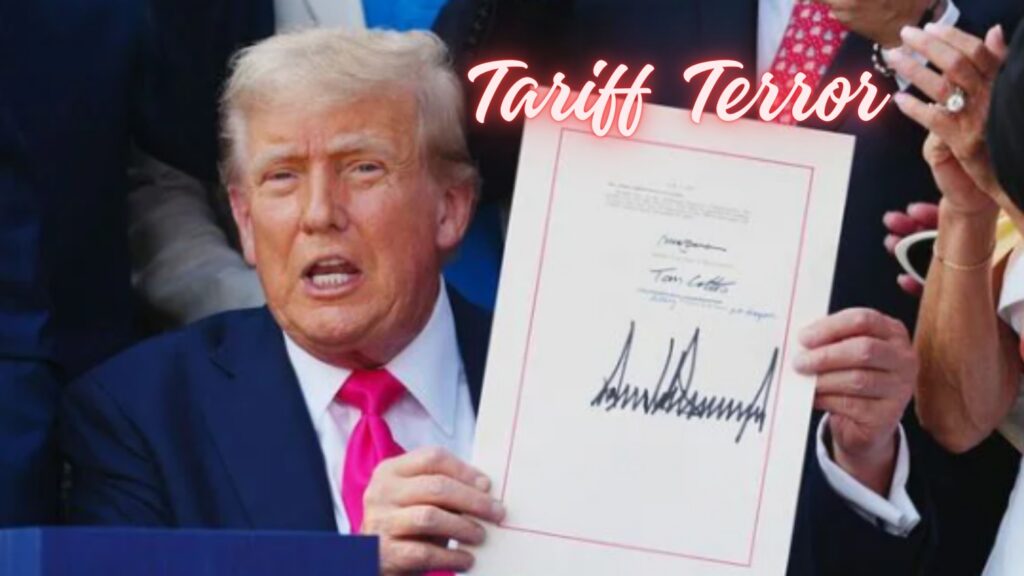Trump’s Tariff Decisions: A Bold Move or Economic Chaos?
President Trump’s new tariffs on over 70 countries are shaking global markets. In this post, we explore the potential impacts and what this means for international trade and the U.S. economy.
The Global Ripple of Trump’s Tariffs
When President Donald Trump announced sweeping new tariffs on over 70 countries, including major economies like India, Taiwan, and South Africa, the ripple effect was instant. Traders panicked, markets trembled, and headlines shouted “Trade War” louder than ever before. But what does it really mean for us on the ground? Whether you’re a business owner, a consumer, or just someone trying to navigate the economic winds, these tariff decisions are more than just political maneuvers—they’re a reflection of global economic tension.
In the short term, the tariffs, ranging from 20% to 30% on imports from several countries, have caused sharp declines in major stock indices like the Dow Jones and Nasdaq. The question on everyone’s mind now is: Will these tariffs lead to long-term stability or will they spiral into a deeper trade conflict?
A Trade War Like No Other: What’s Really at Stake?
The Economic Ramifications of Trump’s Tariffs
When Trump announced his latest tariff decisions, the U.S. was already grappling with a disappointing jobs report and a sluggish economy. The tariffs targeted a range of industries, from tech to consumer goods. For countries like India, Taiwan, and South Africa, these decisions feel like a punch to the gut.
You see, tariffs are essentially taxes that consumers pay when products cross international borders. These new duties are not just a matter of trade politics—they directly affect consumers like you and me. Think about it: Your phone, your car, the clothes you wear—they could all become more expensive if the cost to import them rises. This is particularly true for countries whose economies are deeply intertwined with the U.S.
Example: India’s Struggling Tech Industry
India, a major exporter of tech products and software to the U.S., is already feeling the heat. The 25% tariff slapped on Indian imports is expected to hurt the tech sector hard. According to recent reports, a significant portion of the software development outsourced by U.S. companies comes from India. Now, those companies are going to have to pay more, or worse, look elsewhere for cost-effective alternatives.
But it’s not just about the products—we’re talking about jobs. In countries like Taiwan, the impact on semiconductor and electronics manufacturing will have ripple effects across thousands of tech workers who depend on these exports for their livelihood.
The Immediate Market Reaction: Panic or Precision?
A Look at the Market Sell-off
The immediate market reaction to Trump’s tariff announcements was nothing short of chaotic. Stock prices took a dive, and global markets were shaken by the sheer unpredictability of it all. Investors sold off shares, fearing that these tariffs could set off a global economic downturn.
However, in this chaos, some saw opportunity. Large corporations with the power to shift production away from affected regions could potentially weather the storm. For example, tech giants like Apple, which manufacture a significant portion of their products in China and Taiwan, might be able to adapt their supply chains or pass some of the added costs onto consumers.
The question remains: Can the stock market sustain this volatility? Or will the global economy adjust to the new normal?
A Fed in Crisis: Will Interest Rates Save the Day?
The Pressure Mounts on the Federal Reserve
As the markets plunge, attention is shifting to the Federal Reserve. Trump has openly called for the Fed to cut interest rates in response to the latest jobs report, which showed a sharp slowdown in job creation for July. Economists are divided on whether rate cuts will truly stabilize the economy.
On one hand, lower interest rates could stimulate spending and borrowing, boosting economic activity. On the other hand, lowering rates too quickly could fuel inflation and lead to more volatility. So, what’s the right call here? The Fed’s decision could either stabilize the economy or escalate the trade tension further.
Some analysts argue that this is just a quick fix, one that may not address the underlying economic issues Trump’s tariffs are creating. A trade war, after all, is not something you can simply fix with lower interest rates.
Diplomacy, Anyone? The Global Pushback Against the Tariffs
Countries Struggling to Cope with Tariff Pressure
Despite the political bravado in Washington, the international community has not taken these new tariffs lightly. Nations like Canada, Switzerland, and Mexico are scrambling to negotiate exemptions, but these diplomatic talks are a slow burn. In fact, some countries are even making concessions. For instance, Lesotho, a small African nation, managed to negotiate its tariff rate down from 50% to 15%, showcasing the power of strategic negotiation.
But not all countries are happy with these trade moves. Many experts argue that these tariffs could backfire. Countries that are hit hard might retaliate, leading to a full-blown trade war. For instance, China—already a central player in Trump’s earlier tariff decisions—could ramp up its retaliation, creating even greater global instability.
What’s Next for Global Diplomacy?
It remains to be seen whether countries will unite against these tariffs or if individual nations will buckle under pressure. What’s certain, however, is that the global pushback is intensifying, and the world is watching carefully.
Will These Tariffs Be the End of Global Trade as We Know It?
The new tariffs introduced by Trump have the potential to reshape the world’s economic landscape, and the outcome is still unclear. While some may argue that these moves are necessary to protect American businesses and jobs, others view them as a dangerous path toward economic isolationism.
If the situation continues to escalate, we could see long-lasting effects on the global economy, affecting everything from employment rates to the cost of living. But let’s not forget: trade wars are not just numbers on a spreadsheet. They have real-world consequences on ordinary people. Whether it’s a higher cost for your morning cup of coffee or a more expensive plane ticket for your next vacation, we all feel the impact.
Conclusion: The Future of Global Trade Is Uncertain, but We Must Adapt
The world is in the midst of a pivotal moment. Whether these tariffs mark the beginning of a new era in global trade or simply a temporary bump in the road, one thing is clear: we are all connected in this globalized world. What happens in Washington can, and will, affect millions across the globe.
As the situation develops, we need to stay informed and consider how these economic shifts might impact our everyday lives. Will the U.S. economy thrive under Trump’s tariffs, or will we witness the unraveling of decades of global cooperation? The answer, as always, lies in the complexities of global trade, and only time will tell.
What do you think about Trump’s new tariffs? Will they help the U.S. economy, or are we headed for a global economic downturn? Drop your thoughts in the comments below, and don’t forget to share this post with others who might want to join the conversation.
Trump’s Tariff Threats: A High-Stakes Gamble for Global Trade –







https://t.me/s/ud_voDkA
https://t.me/s/uD_ggbET
https://t.me/s/Ud_GAMa
https://t.me/s/UD_PlAYfoRtuNA
https://t.me/s/ud_poKERdoM
https://t.me/s/official_1win_aviator/38
https://t.me/s/Ud_FlagMAN
https://t.me/s/Ud_IZZI
https://t.me/s/Ud_rIoBet
https://t.me/s/official_1win_aviator/51
https://t.me/s/UD_pinCo
https://t.me/s/ud_MarTin
https://t.me/s/UD_ROX
https://t.me/s/Ud_KEnT
https://t.me/s/uD_CASinO_X
https://t.me/s/tf_1win
https://t.me/s/tf_1win
https://t.me/s/kfo_1win
https://t.me/s/Top_bk_ru
https://t.me/s/uD_Izzi
https://t.me/s/Ud_gAMa
https://t.me/s/official_1win_aviator/223
https://t.me/s/ud_PLAYfortunA
https://t.me/s/UD_VODKA
https://t.me/s/ud_gIZbo
https://t.me/s/uD_fLAgmAn
https://t.me/s/ud_keNT
https://t.me/s/UD_BOoi
https://t.me/s/uD_mArTIN
https://t.me/s/ud_rox
https://t.me/s/uD_LEgzO
https://t.me/s/ke_1Win
https://t.me/s/official_1win_aviator/70
https://t.me/s/ke_Volna
https://t.me/s/ke_Daddy
https://t.me/s/ke_Booi
https://t.me/s/ke_kent
https://t.me/s/ke_PlayFortuna
https://t.me/s/kef_R7
https://t.me/s/ke_Vulkan
https://t.me/s/kef_Lex
https://t.me/s/ke_Legzo
https://t.me/s/ke_DragonMoney
https://t.me/s/ke_GGBet
https://t.me/s/ke_Izzi
https://t.me/s/kef_beef
https://t.me/s/ke_Kometa
https://t.me/s/ke_Monro
https://t.me/s/ke_Martin
https://t.me/s/ke_CatCasino
https://t.me/s/ke_Pokerdom
https://t.me/s/ke_1xSlots
https://t.me/s/ke_Drip
https://t.me/s/ke_MrBit
https://t.me/s/ke_Sol
https://t.me/s/ke_Riobet
https://t.me/s/ke_Casino_X
https://t.me/s/ke_Starda
https://t.me/s/ke_Leon
https://t.me/s/kef_Rox
https://t.me/s/ke_1Go
https://t.me/official_1win_aviator/576
https://t.me/s/ke_1xbet
https://t.me/s/ke_MostBet
https://t.me/s/official_1win_aviator/136
https://t.me/s/ke_Gizbo
https://t.me/s/ke_Irwin
https://t.me/s/ke_Gama
https://t.me/s/ke_Vodka
https://t.me/s/ke_Stake
https://t.me/s/top_kazino_z
https://t.me/s/topcasino_v_rossii
https://t.me/s/a_Top_onlinecasino/15
https://t.me/s/a_Top_onlinecasino/20
https://t.me/s/a_Top_onlinecasino/21
https://t.me/s/a_Top_onlinecasino/4
https://t.me/s/a_Top_onlinecasino/17
https://t.me/a_Top_onlinecasino/4
https://t.me/s/a_Top_onlinecasino/3
https://t.me/a_Top_onlinecasino/17
https://t.me/a_Top_onlinecasino/8
https://t.me/a_Top_onlinecasino/5
https://t.me/s/a_Top_onlinecasino/12
https://t.me/topcasino_rus/
https://t.me/s/official_Fresh_ed
https://t.me/s/official_1xSlots_ed
https://t.me/s/official_Volna_ed
https://t.me/s/official_1xbet_es
https://t.me/s/official_Flagman_es
https://t.me/s/official_R7_ed
https://t.me/s/official_Kent_ed
https://t.me/s/official_JoyCasino_ed
https://t.me/s/official_Kent_es
https://t.me/s/official_Kometa_es
https://t.me/s/official_Pokerdom_ed
https://t.me/s/official_PlayFortuna_es
https://t.me/s/official_Izzi_ed
https://t.me/s/official_Starda_es
https://t.me/s/official_CatCasino_es
https://t.me/s/official_1Go_es
https://t.me/s/official_1Go_ed
https://t.me/s/official_Irwin_es
https://t.me/s/official_Booi_ed
https://t.me/s/official_Gama_ed
https://t.me/s/official_DragonMoney_es
https://t.me/s/official_Gama_es
https://t.me/s/official_Riobet_es
https://t.me/s/official_Irwin_ed
https://t.me/iGaming_live/4547
https://t.me/s/official_Rox_es
https://t.me/s/official_MostBet_ed
https://t.me/s/Legzo_egs/11
https://t.me/MostBet_egs/3
https://t.me/CasinoX_egs/19
https://t.me/s/Vodka_egs/18
https://t.me/s/Martin_egs/9
https://t.me/s/Stake_egs/11
https://t.me/s/Stake_egs/22
https://t.me/s/?@DragonMoney_egs/13
https://t.me/s/Sol_egs/7
https://t.me/s/Gama_egs/7
https://t.me/s/Booi_egs/7
https://t.me/s/Vodka_egs/8
https://t.me/s/Jet_egs/22
https://t.me/CasinoX_egs/5
https://t.me/s/MostBet_egs/4
https://t.me/Jet_egs/16
https://t.me/s/Rox_egs/15
https://t.me/s/PlayFortuna_egs/5
https://t.me/s/Flagman_egs/14
https://t.me/s/Fresh_egs/19
https://t.me/s/Starda_egs/13
https://t.me/JoyCasino_egs/8
https://t.me/Volna_egs/22
https://t.me/Pinco_egs/4
https://t.me/iGaming_live/4651
https://t.me/s/Jet_egs/4
https://t.me/va_1xbet/18
https://t.me/va_1xbet/11
https://t.me/va_1xbet/22
https://t.me/va_1xbet/10
https://t.me/s/va_1xbet/19
https://t.me/s/va_1xbet/17
https://t.me/va_1xbet/16
https://t.me/s/va_1xbet/3
https://t.me/s/va_1xbet/9
https://t.me/va_1xbet/9
You have observed very interesting details ! ps decent website .
https://t.me/s/va_1xbet/22
https://t.me/s/va_1xbet/16
https://t.me/va_1xbet/19
https://t.me/surgut_narashchivaniye_nogtey/10
https://t.me/s/surgut_narashchivaniye_nogtey/13
https://t.me/surgut_narashchivaniye_nogtey
https://t.me/s/rating_online
I am extremely inspired along with your writing abilities and also with the layout in your weblog. Is that this a paid theme or did you customize it yourself? Either way stay up the excellent high quality writing, it is rare to look a nice blog like this one today..
https://t.me/ah_1xbet/4
https://t.me/s/ah_1xbet/8
https://t.me/ah_1xbet/13
https://t.me/s/ah_1xbet/10
https://t.me/s/ah_1xbet/18
https://t.me/s/ah_1xbet/16
https://t.me/ah_1xbet/15
https://t.me/ah_1xbet/11
https://t.me/s/ah_1xbet/3
https://t.me/ah_1xbet/7
https://t.me/ah_1xbet/20
https://t.me/s/Best_rating_casino
https://t.me/s/reyting_topcazino/15
https://t.me/topcasino_rus/
https://t.me/a_Topcasino/10
I have learn a few just right stuff here. Certainly value bookmarking for revisiting. I surprise how so much effort you place to create this kind of fantastic informative site.
https://t.me/a_Topcasino/2
https://t.me/a_Topcasino/3
https://t.me/a_Topcasino/8
https://t.me/a_Topcasino/4
https://t.me/top_ratingcasino/3
https://t.me/top_ratingcasino/9
https://t.me/a_Topcasino/7
https://t.me/top_ratingcasino/2
https://telegra.ph/top-kazino-11-14
https://telegra.ph/Top-kazino-11-14-2
https://t.me/s/kazino_bez_filtrov
https://t.me/kazino_bez_filtrov
https://t.me/da_1xbet/15
https://t.me/da_1xbet/14
https://t.me/da_1xbet/8
https://t.me/da_1xbet/10
https://t.me/da_1xbet/6
https://t.me/da_1xbet/4
https://t.me/da_1xbet/7
https://t.me/da_1xbet/9
https://t.me/da_1xbet/13
https://t.me/rq_1xbet/1504
https://t.me/rq_1xbet/1530
https://t.me/rq_1xbet/939
https://t.me/rq_1xbet/1481
https://t.me/s/rq_1xbet/1192
https://t.me/s/rq_1xbet/1216
https://t.me/s/rq_1xbet/1073
https://t.me/s/rq_1xbet/825
https://t.me/s/reyting_topcazino/25
https://t.me/s/rq_1xbet/937
https://t.me/Official_1xbet1/1050
https://t.me/s/Official_1xbet1/309
https://t.me/Official_1xbet1/949
https://t.me/Official_1xbet1/455
https://t.me/Official_1xbet1/333
https://t.me/s/Official_1xbet1/1086
https://t.me/Official_1xbet1/456
https://t.me/Official_1xbet1/953
https://t.me/s/kazino_s_licenziei/5
https://t.me/s/Topcasino_licenziya/25
https://t.me/Topcasino_licenziya/56
https://t.me/Topcasino_licenziya/44
https://t.me/s/kazino_s_licenziei/8
https://t.me/Topcasino_licenziya/12
https://t.me/Topcasino_licenziya/16
https://t.me/s/top_online_kazino/8
https://t.me/s/top_online_kazino/10
https://t.me/s/top_online_kazino/6
https://t.me/s/top_online_kazino/9
https://t.me/top_online_kazino/10
https://t.me/top_online_kazino/8
https://t.me/s/top_online_kazino/4
https://t.me/top_online_kazino/5
https://t.me/s/top_online_kazino/5
https://t.me/s/reyting_kasino
http://images.google.tt/url?q=https://t.me/Official_1xbet_1xbet/515
http://traveleronthego.com/__media__/js/netsoltrademark.php?d=https://t.me/s/Official_1xbet_1xbet/254
http://p-in.it/__media__/js/netsoltrademark.php?d=https://t.me/s/Official_1xbet_1xbet/1383
https://www.avito.ru/surgut/predlozheniya_uslug/krasota/manikyur_pedikyur-ASgBAgICAkSYC6qfAaIrgLgC?q=маникюр
https://www.avito.ru/surgut/predlozheniya_uslug/apparatnyy_manikyur_i_pedikyur_s_pokrytiem_4030660549?utm_campaign=native&utm_medium=item_page_ios&utm_source=soc_sharing_seller
https://clients1.google.gl/url?sa=t&url=https://t.me/Official_1xbet_1xbet/1375
http://images.google.ws/url?q=https://t.me/Official_1xbet_1xbet/151
http://jolleyholding.com/__media__/js/netsoltrademark.php?d=https://t.me/s/Official_1xbet_1xbet/400
https://t.me/s/om_1xbet/14
https://t.me/om_1xbet/4
https://t.me/s/om_1xbet/14
https://t.me/om_1xbet/6
https://t.me/s/om_1xbet/4
https://t.me/s/om_1xbet/6
https://t.me/om_1xbet/5
https://t.me/om_1xbet/9
https://t.me/top_casino_rating_ru/11
https://t.me/om_1xbet/13
https://t.me/of_1xbet/622
Играй 1win online — получи до 15,000? бонусов за первый депозит и наслаждайся лучшими условиями! В нашем онлайн-казино тебя ждут яркие слоты, фриспины и быстрый вывод выигрышей, а ставки на спорт с высокими коэффициентами и лайв-ставки дарят шанс сотворить реальный выигрыш. Открой личный кабинет, сделай минимальный депозит и почувствуй азарт в любое время с круглосуточной поддержкой!
Сколько сахара на 1 кг вишни для вина? Узнайте в нашем личном кабинете 1win и сделайте ставку с бонусом до 5000?! Играйте в онлайн казино, запускайте слоты с фриспинами, делайте ставки на спорт и лайв-ставки — максимальный кэшбэк, быстрый вывод, крутые промокоды и мгновенные выигрыши ждут именно вас.